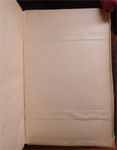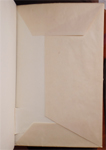100th
MP

|
THE
100th
MONKEY
PRESS |
|
|
|
Limited Editions by Aleister Crowley & Victor B. Neuburg |
|
Bibliographies |
|
Download Texts
»
Aleister
Crowley
WANTED !!NEW!!
|
|
THE SCENTED GARDEN OF ABDULLAH |
|
»» Download Text «« |
Image Thumbnails |
|||||||||||||||||||||||||||||||||||||||
|
Title: |
The Scented Garden of Abdullah the Satirist of Shiraz. Translated from a Rare Indian Ms. by the Late Major Lutiy and Another. |
|
||||||||||||||||||||||||||||||||||||||
|
Variations: |
|
|||||||||||||||||||||||||||||||||||||||
|
Publisher: |
Offered by subscription in 1908 by Probsthain & Co.2 |
|||||||||||||||||||||||||||||||||||||||
|
Printer: |
Philippe Renouard.3 |
|||||||||||||||||||||||||||||||||||||||
|
Published At: |
Paris.3 |
|||||||||||||||||||||||||||||||||||||||
|
Date: |
1910.2 |
|||||||||||||||||||||||||||||||||||||||
|
Edition: |
1st Edition. |
|||||||||||||||||||||||||||||||||||||||
|
Pages: |
viii + 140. |
|||||||||||||||||||||||||||||||||||||||
|
Price: |
State (a) priced at ten guineas and State (b) priced at two guineas by subscription. State (a) priced at fifteen guineas and State (b) priced at three guineas on publication.2 |
|||||||||||||||||||||||||||||||||||||||
|
Remarks: |
Published under the pseudonym of Major Alain Lutiy. Title page printed in black and red. Offered by subscription in 1908 by Probsthain & Co. and published in 1910.2 Gerald Yorke, in his “Bibliography of the Works of Aleister Crowley”, states that the majority of the books were destroyed by HM Customs in 1924.5 Further examination has shown that many copies may have been destroyed prior to the seizure by HM Customs and that only thirty-three copies were seized by HM Customs in 1924 and later destroyed in 1926.4 Crowley met Herbert Charles Jerome Pollitt in October 1897 and is said to have been involved with him in a homosexual relationship. Pollitt is memorialized by Crowley in Chapter XLI “The Riddle”. By taking the first letter of each line of the poem, the name “Herbert Charles Jerome Pollitt” is spelled out. In the next chapter, “Bagh-i-Muattar”, an acrostic spells out Crowley’s name in reverse.6 Shown HERE. |
|||||||||||||||||||||||||||||||||||||||
|
Pagination:1 |
|
|||||||||||||||||||||||||||||||||||||||
|
Contents: |
- Introduction - Περι της Παιδεραστειας
BAGH-I-MUATTAR - I. The Abyss - II. The Jinn-Vision - III. The Ambassadors - IV. Aflatun - V. The Debauch - VI. The Curtain - VII. The Duststorm - VIII. The Whore - IX. The Hakim - X. The Black Stone - XI. Aziz - XII. The Apples - XIII. The Blind Beggar - XIV. The Comparisons - XV. The Complaisances - XVI. The Jasmine-Jar - XVII. The Complaints - XVIII. The Tryst - XIX: The Cherry-Tree - XX. The Qasi - XXI. The Love-Potion - XXII. The Forehead-Writing - XXIII. Mirrikh - XXIV. The Blasphemer - XXV. The Atheist - XXVI. The Tower of Shinar - XXVII. The Camel Rider - XXVIII. The Potter - XXIX. The Mirag - XXX. The Scribe - XXXI. The Unicorn - XXXII. The Bull-Frogs - XXXIII. The Mullah - XXXIV. The Talisman - XXXV. Zemzem - XXXVI. Suraiya - XXXVII. The Crane - XXXVIII. The Garden - XXXIX. The Bargainings - XL. The Namings - XLI. The Riddle - XLII. Bagh-I-Muattar |
|||||||||||||||||||||||||||||||||||||||
|
Author’s Working Versions: |
|
|||||||||||||||||||||||||||||||||||||||
|
Other Known Editions: |
||||||||||||||||||||||||||||||||||||||||
|
Bibliographic Sources: |
|
|||||||||||||||||||||||||||||||||||||||
|
Comments by Aleister Crowley: |
We had resumed Magical work, in a desultory way, on finding that Mathers was attacking us. He succeeded in killing most of the dogs. (At this time I kept a pack of bloodhounds and went man-hunting over the moors.) The servants too were constantly being made ill, one in one way, and one in another. We therefore employed the appropriate talismans from The Book of the Sacred Magic of Abra-Melin against him, evoking Beelzebub and his forty-nine servitors. Rose had suddenly acquired the power of clairvoyance. Her description of these servitors is printed in The Bagh-i-Muattar, pages 39, 40. — The Confessions of Aleister Crowley. New York, NY. Hill and Wang, 1969. Page 408. ______________________________
I spent most of my time writing ghazals, purporting to be by a certain Abdullah al Haji (Haji, with a soft “h”, satirist, as opposed to Haji with a hard “h”, pilgrim) of Shiraz. I caused him to flourish about 1600 A.D., but gave to the collection of his ghazals the title Bagh-i-Muattar (The Scented Garden), which implies the date 1905, the value of the Arabic letters of the title adding up to the equivalent of that year of the Hegira. I also invented an Anglo Indian major to find, translate and annotate the manuscript, an editor to complete the work of that gallant soldier (killed in South Africa) and a Christian clergyman to discuss the matter of the poem from the peculiar point of view of high Anglicanism. The ghazals themselves are rendered sometimes in the supposed original monorime, sometimes in prose, and the annotations contain a great deal of the more esoteric information about the East, which I had picked up from time to time. It is especially to be noted that, although I have packed every kind of magical and mystical lore into the volume, there is nowhere any reference to The Book of the Law. I was setting my whole strength against the Secret Chiefs. I was trying to forget the whole business. The book itself is a complete treatise on mysticism, expressed in the symbolism prescribed by Persian piety. It describes the relations of God and man, explains how the latter falls from his essential innocence by allowing himself to be deceived by the illusion of matter. His religion cease to be real and become formal; he falls into sin and suffers the penalty thereof. God prepares the pathway of regeneration and brings him through shame and sorrow to repentance, thus preparing the mystical union which restores man to his original privileges, free will, immortality, the preception of truth and so on. I put the last ounce of myself into this book. My previous efforts in the same direction would have deceived nobody, but the Bagh-i-Muatar, despite my inability to produce the Persian original—my excuse was that it was rare and held the most sacred and most secret, but was being copied for me—persuaded even experienced scholars that it was genuine. It was issued by Probsthain & Co., by private subscription, in 1910. I have heard of a copy changing hands at fifty guineas. This spurt of genius is an eloquent portrait of my mind at this time. I was absolutely convinced of the supreme importance of devoting my life to attaining Samadhi, conscious communion with the Immanent Soul of the Universe. I believed in mysticism. I understood perfectly the essence of its method and the import of its attainment, but I felt compelled to express myself in a satirical and (it might appear to some) almost scandalous form. I testified to the tremendous truth by piling fiction upon fiction. I did not know it. I did not suspect it, but the Bagh-i-Muattar is a symptom of supreme significance. I was on the brink of a totally new development. — The Confessions of Aleister Crowley. New York, NY. Hill and Wang, 1969. Pages 451-452. ______________________________
Even this did not exhaust my creative energy. As in Cairo in 1902 I had started the “Lover’s Alphabet”, on the ground that the most primitive kind of lyrics or odes was in some way the most appealing and immortal, so I decided to write a series of hymns to the Blessed Virgin Mary in the simplest possible style. I must not be thought exactly insincere, though I had certainly no shadow of belief in any of the Christian dogmas, least of all in this adaptation and conglomeration of Isis, Semele, Astarte, Cybele, Freya, and so many others; I simply tried to see the world through the eyes of a devout Catholic, very much as I had done with the decadent poet of White Stains, the Persian mystic of the Bagh-i-Muattar, and so on. I was, in fact, adopting another alias—in the widest sense of the word. — The Confessions of Aleister Crowley. New York, NY. Hill and Wang, 1969. Page 559. |
|||||||||||||||||||||||||||||||||||||||
|
Reviews: |
|
|||||||||||||||||||||||||||||||||||||||






